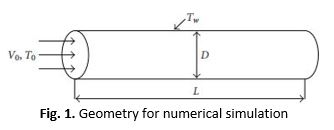Multiphase CFD Investigation on Convective Heat Transfer Enhancement for Turbulent Flow of Water-Al2O3 Nanofluid
DOI:
https://doi.org/10.37934/cfdl.13.10.1124Keywords:
Nanofluid, forced convection, multiphase, heat transferAbstract
Because of extraordinary heat transfer capability, nanofluids have become a potential interest in engineering sectors. Despite being a multiphase fluid, nanofluids were treated as single phase fluids in many previous studies and comparison between single and two phase models was drawn. Examining nanofluids capability to augment heat transfer is one of the keys to utilize them properly in the field of thermofluids. However, the optimal multiphase model to simulate nanofluids heat transfer enhancement is yet to be found out. In this study, the method of computational fluid dynamics has been used to simulate flow of water-Al2O3 nanofluid in a circular pipe in the purpose of identifying the best multiphase model to simulate heat transfer enhancement of nanofluids. Two multiphase models have been taken into account: Volume of Fluid and Mixture model. Three different volume fractions of nanoparticles in nanofluid have been tested for each of these models such as 1%,4% and 6% for highly turbulent flows where Reynolds number was ranged between 20000 to 80000. The standard k-ɛ turbulence model has been employed to model the flow of nanofluid with the mentioned multiphase models in the present study. The results have been carried out in forms of correlation between Re and Nu and have been compared with existing experimental results. The results showed that the heat transfer enhancement of nanofluid is mostly dominated by concentration of nanoparticles present in the fluid and suggested that Mixture model is suitable for predicting convective heat transfer enhancement of nanofluid for cases with high particle concentration though the necessity of further experimental study in some scopes has been detected.
Downloads
References
Sreelakshmy, K. R., Aswathy S. Nair, K. Vidhya, T. Saranya, and Sreeja C. Nair. "An overview of recent nanofluid research." International Research Journal of Pharmacy 5, no. 4 (2014): 239-243. https://doi.org/10.7897/2230-8407.050451
Lee, Ji-Hwan, Seung-Hyun Lee, Chul Choi, Seok Jang, and Stephen Choi. "A Review of Thermal Conductivity Data, Mechanisms and Models for Nanofluids." International Journal of Micro-Nano Scale Transport (2011). https://doi.org/10.1260/1759-3093.1.4.269
Mousavi, S. M., F. Esmaeilzadeh, and X. P. Wang. "Effects of temperature and particles volume concentration on the thermophysical properties and the rheological behavior of CuO/MgO/TiO2 aqueous ternary hybrid nanofluid." Journal of Thermal Analysis and Calorimetry 137, no. 3 (2019): 879-901. https://doi.org/10.1007/s10973-019-08006-0
Kriby, Saliha, Mohamed Announ, and Tayeb Kermezli. "2D CFD simulation to investigate the thermal and hydrodynamic behavior of nanofluid flowing through a pipe in turbulent conditions." CFD Letters 11, no. 11 (2019): 58-75.
Fard, M. Haghshenas, M. Nasr Esfahany, and M. R. Talaie. "Numerical study of convective heat transfer of nanofluids in a circular tube two-phase model versus single-phase model." International Communications in Heat and Mass Transfer 37, no. 1 (2010): 91-97. https://doi.org/10.1016/j.icheatmasstransfer.2009.08.003
Saghir, M. Ziad, Amirhossein Ahadi, Tooraj Yousefi, and Bahram Farahbakhsh. "Two-phase and single phase models of flow of nanofluid in a square cavity: comparison with experimental results." International Journal of Thermal Sciences 100 (2016): 372-380. https://doi.org/10.1016/j.ijthermalsci.2015.10.005
Esfandiary, M., A. Habibzadeh, and H. Sayehvand. "Numerical Study of Single Phase/Two-Phase Models for Nanofluid Forced Convection and Pressure Drop in a Turbulence Pipe Flow." Transp Phenom Nano Micro Scales 4, no. 1 (2016): 11-18.
Kakaç, Sadık, and Anchasa Pramuanjaroenkij. "Single-phase and two-phase treatments of convective heat transfer enhancement with nanofluids-A state-of-the-art review." International Journal of Thermal Sciences 100 (2016): 75-97. https://doi.org/10.1016/j.ijthermalsci.2015.09.021
Lotfi, R., Y. Saboohi, and A. M. Rashidi. "Numerical study of forced convective heat transfer of nanofluids: comparison of different approaches." International Communications in Heat and Mass Transfer 37, no. 1 (2010): 74-78. https://doi.org/10.1016/j.icheatmasstransfer.2009.07.013
Akbari, M., N. Galanis, and A. Behzadmehr. "Comparative analysis of single and two-phase models for CFD studies of nanofluid heat transfer." International Journal of Thermal Sciences 50, no. 8 (2011): 1343-1354. https://doi.org/10.1016/j.ijthermalsci.2011.03.008
Göktepe, Sinan, Kunt Atalık, and Hakan Ertürk. "Comparison of single and two-phase models for nanofluid convection at the entrance of a uniformly heated tube." International Journal of Thermal Sciences 80 (2014): 83-92. https://doi.org/10.1016/j.ijthermalsci.2014.01.014
Safaei, Mohammad Reza, A. Jahanbin, Ali Kianifar, Samira Gharehkhani, Akeel Shebeeb Kherbeet, Marjan Goodarzi, and Mahidzal Dahari. "Mathematical modeling for nanofluids simulation: a review of the latest works." Modeling and Simulation in Engineering Sciences (2016): 189-220. https://doi.org/10.5772/64154
Najim, Monssif, Abderrahman Nait Alla, and Adil Charef. "Comparative numerical study of single and two-phase models of nanofluid liquid film evaporation in a vertical channel." In MATEC Web of Conferences, vol. 307, p. 01034. EDP Sciences, 2020. https://doi.org/10.1051/matecconf/202030701034
Ambreen, Tehmina, Arslan Saleem, and Cheol Woo Park. "Homogeneous and Multiphase Analysis of Nanofluids Containing Nonspherical MWCNT and GNP Nanoparticles Considering the Influence of Interfacial Layering." Nanomaterials 11, no. 2 (2021): 277. https://doi.org/10.3390/nano11020277
Hanafizadeh, P., M. Ashjaee, M. Goharkhah, K. Montazeri, and M. Akram. "The comparative study of single and two-phase models for magnetite nanofluid forced convection in a tube." International Communications in Heat and Mass Transfer 65 (2015): 58-70. https://doi.org/10.1016/j.icheatmasstransfer.2015.04.012
Davarnejad, Reza, and Maryam Jamshidzadeh. "CFD modeling of heat transfer performance of MgO-water nanofluid under turbulent flow." Engineering Science and Technology, an International Journal 18, no. 4 (2015): 536-542. https://doi.org/10.1016/j.jestch.2015.03.011
Bianco, Vincenzo, Oronzio Manca, and Sergio Nardini. "Numerical simulation of water/Al2O3 nanofluid turbulent convection." Advances in Mechanical Engineering 2 (2010): 976254. https://doi.org/10.1155/2010/976254
Launder, B. E., and D. B. Spalding. "The numerical computation of turbulent flows." Computer Methods in Applied Mechanics and Engineering 3, no. 2 (1974): 269-289. https://doi.org/10.1016/0045-7825(74)90029-2
Alawadhi, Esam M. Finite element simulations using ANSYS. CRC Press, 2015. https://doi.org/10.1201/b18949
Pak, Bock Choon, and Young I. Cho. "Hydrodynamic and heat transfer study of dispersed fluids with submicron metallic oxide particles." Experimental Heat Transfer an International Journal 11, no. 2 (1998): 151-170. https://doi.org/10.1080/08916159808946559




























